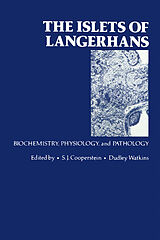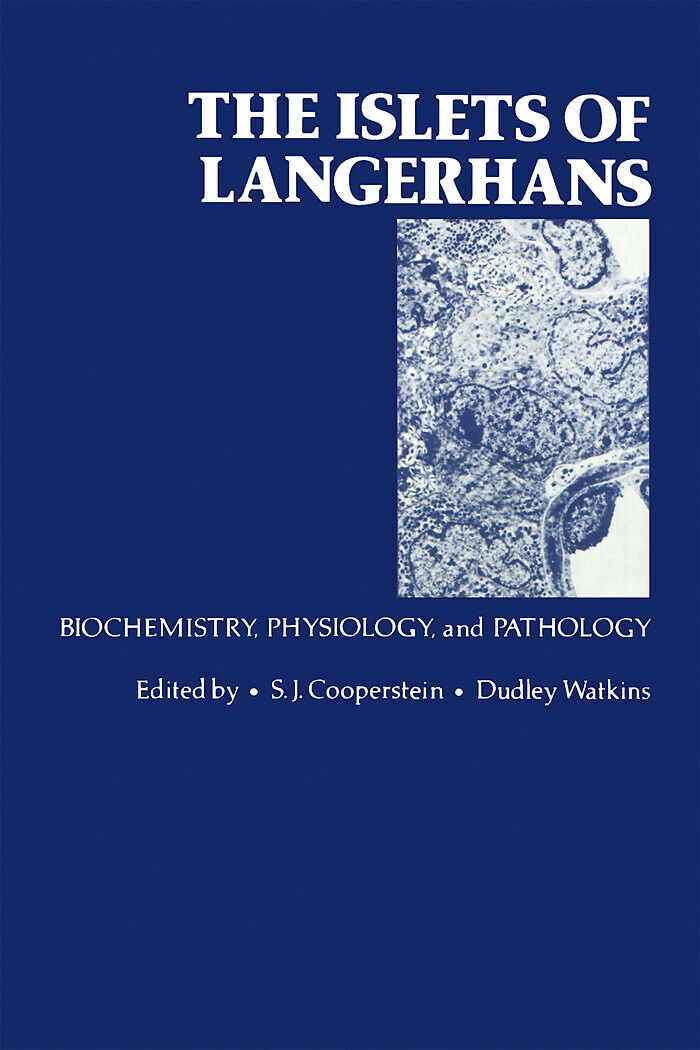The Islets of Langerhans
Format:
E-Book (pdf)
EAN:
9780323147330
Untertitel:
Biochemistry, Physiology, and Pathology
Genre:
Medizin
Herausgeber:
Elsevier Science & Techn.
Anzahl Seiten:
520
Erscheinungsdatum:
02.12.2012
The Islets of Langerhans: Biochemistry, Physiology, and Pathology reviews the state of knowledge in the complex phenomena involved in the functioning of the multiendocrine organ, the islet of Langerhans, and the various influences that can lead to its abnormal functioning. The volume highlights major gaps in knowledge and indicates the directions for research on the major functioning of this organ and the defects leading to its major pathology, diabetes mellitus.
The book is organized into three parts. Part I provides the necessary background information on the nature and development of the islet of Langerhans. It includes studies on the evolution of knowledge of the ever-increasing number of cell types found in islet tissue; and fetal development of the functional capacities of the islet cells. Part II is devoted to the synthesis and secretion of islet hormones, beginning with a chapter on the membrane transport systems of islet tissue as a prelude to subsequent examination of their role in the regulation of these processes. Part III examines the effects of deleterious conditions and agents on the morphology and function of islet cells.
This book is intended for researchers in endocrinology, particularly those interested in pancreatic hormones, graduate students in endocrinology, and medical endocrinologists interested in diabetes. It will also be useful to physiologists and biochemists studying peptide synthesis and secretion.
Inhalt
List of Contributors
Foreword
Preface
I. Morphology and Development of Islet Tissue
1. Morphological Characterization of Islet Cell Diversity
I. Introduction
II. Cells (ß Cells)
III. A Cells (a Cells and a2 Cells)
IV. C Cells
V. D Cells (a1 Cells)
VI. Cells
VII. F Cells (PP Cells)
VIII. Other Islet Cells
IX. Innervation
X. Vasculature
References
2. Functional Development of the Pancreatic Islets
I. Introduction
II. Stages of Metabolic Ontogeny
III. Development of the Pancreas
IV. Development of Related Endocrine Function
V. Development of Target Systems
VI. Role of Nutrition
References
II. Synthesis and Secretion of Islet Hormones
3. Transport Systems of Islet Cells
I. Introduction
II. Sugars
III. Amino Acids
IV. Inorganic Ions
V. Biogenic Amines
VI. Sulfonylureas
VII. Methylxanthines
VIII. Thiol Reagents
IX. ß-Cytotoxic Agents
X. Markers for Transmembrane pH or Electrical Potential Gradients
References
4. Biosynthesis of Insulin
I. Insulin Biosynthesis
II. Regulation of Insulin Biosynthesis
References
5. Interactions of Cell Organelles in Insulin Secretion
I. Plasma Membrane
II. Insulin Secretory Granules
III. Microtubules and Microfilaments
IV. Emiocytosis
V. Concluding Comments
References
6. Metabolic Controls of Insulin Secretion
I. Introduction
II. General Considerations
III. Insulin Secretory Responses to Potential ß-Cell Metabolic Substrates
IV. Experimental Manipulations
V. Metabolites and Cofactors of Possible Importance in Stimulus-Secretion Coupling
VI. Conclusions
References
7. Inorganic Ions in Insulin Secretion
I. Introduction
II. Participation of Ions in the Recognition of Insulinotropic Agents
III. Participation of Ions in the Coupling of Stimulation to Release
IV. Participation of Ions in the Mechanical Events Leading to Insulin Release
V. Conclusion
References
8. Interrelationships between Prostaglandins and Biogenic Amines during Modulation of Beta-Cell Function
I. Introduction
II. Actions of Prostaglandins and Biogenic Amines on Insulin Secretion
III. Biogenic Amines and Beta-Cell Function
IV. Interrelationships between Prostaglandins and Biogenic Amines
V. Implications for the Pathogenesis and Treatment of Diabetes Mellitus
References
9. Biosynthesis of Glucagon and Somatostatin
I. Introduction
II. Glucagon Biosynthesis
III. Somatostatin Biosynthesis
IV. Discovery of Preproglucagons and Preprosomatostatins
V. Conversion of Islet Prohormones at the Subcellular Level
VI. Current Directions in Research on Islet Hormone Biosynthesis
References
10. Secretion of Glucagon
I. Introduction
II. Determinants of Glucagon Secretion
III. Future Research Directions
References
11. Somatostatin and Its Role in Insulin and Glucagon Secretion
I. Introduction
II. Actions of Somatostatin on the Release of Pancreatic Hormones
III. Radioimmunoassay for Somatostatin
IV. Release of Pancreatic Somatostatin
V. Physiological Role of Somatostatin in the Pancreas
VI. Conclusions
References
12. Synthesis, Storage, Secretion, and Significance of Pancreatic Polypeptide in Vertebrates
I. Introduction
II. Cellular Origin
III. Synthesis and Chemistry
IV. Secretion: Prandial, Neural, and Hormonal Correlates
V. Function of Pancreatic Polypeptide
VI. Pathophysiological Correlates
VII. Summary of Current Information
Significant Reviews
References
III. Pathology of the Islets of Langerhans
13. Islet Changes in Human Diabetes
I. Historical Background
II. Quantitative Islet Changes
III. Qualitative Islet Changes
IV. Changes in the Exocrine Pancreas
V. Morphological Aspects of the Pathogenesis of Human Diabetes
References
14. Animal Models of Spontaneous Diabetes
I. Introduction
II. The Chinese Hamster (Cricetulusgriseus)
III. The db Mouse (C57BL/KsJdb)
IV. The KK Mouse
V. The Spiny Mouse (Acomys cahirinus)
VI. The BB/Wistar Rat
VII. The Guinea Pig
VIII. The Sand Rat (Psammomys obesus)
IX. Clinical Diabetes
X. Overview and Future Research Needs
References
15. Action of Toxic Drugs on Islet Cells
I. Introduction
II. Alloxan
III. Streptozotocin
References
16. Role of Viruses in Diabetes
I. Mechanisms of Virus-Induced Cell Disease
II. Laboratory Techniques for Studying Virus-Pancreatic Beta-Cell Interactions
III. Association of Viral Infections in Humans with Insulin-Dependent Diabetes Mellitus
IV. Animal Models of Diabetes Mellitus with a Definite or Possible Viral Etiology
V. Interrelationship of Viral Infection and Autoimmunity
VI. Recent Epidemiological Studies
VII. Summary
References
17. Autoimmunity and Diabetes
I. Introduction
II. Evidence for Autoimmunity in Diabetes
III. The Genetics of IDDM
IV. Environmental Triggers for Autoimmune IDDM
V. Future Directions
References
18. Insulin, Glucagon, an…

Leider konnten wir für diesen Artikel keine Preise ermitteln ...
billigbuch.ch sucht jetzt für Sie die besten Angebote ...
Die aktuellen Verkaufspreise von 3 Onlineshops werden in Realtime abgefragt.
Sie können das gewünschte Produkt anschliessend direkt beim Anbieter Ihrer Wahl bestellen.
Loading...
Die aktuellen Verkaufspreise von 3 Onlineshops werden in Realtime abgefragt.
Sie können das gewünschte Produkt anschliessend direkt beim Anbieter Ihrer Wahl bestellen.
| # | Onlineshop | Preis CHF | Versand CHF | Total CHF | ||
|---|---|---|---|---|---|---|
| 1 | Seller | 0.00 | 0.00 | 0.00 |
